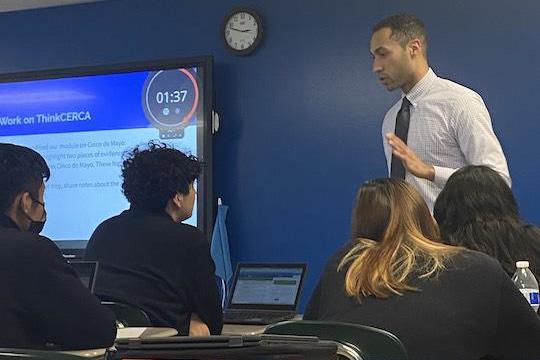For years, when people have asked me why I wanted to become a teacher, my first response has been, “Because I had great English teachers in high school.” My motivation for being a teacher is more complex and includes wanting to foster the development of young people, but when anyone asks, I cannot help but return to the moment when my fire for teaching was first sparked at Bishop Canevin High School in Pittsburgh.
My freshman year English teacher was Mrs. Finnegan, a caring woman and master of dry humor who beautifully handled the transition from grade school to high school. She fostered my love of short stories, keeping my young mind engaged with tales that always had a twist at the end. The names of some of those stories still hold a hallowed place in my heart: “The Chaser,” “Love Is A Fallacy,” “The Fall of the House of Usher.” On Mondays, she would post creative writing prompts on the board—it could be the names of paint colors or a quote—and we would have time to free write during the beginning or entirety of class. In Mrs. Finnegan’s classroom, I fell in love with English.
At Bishop Canevin, no teacher was as revered as my sophomore English teacher, Mr. Fazio. Affectionately known as “The Faz” (whether his students gave him the nickname or he came up with it himself was always unclear to me), I knew Mr. Fazio as a teacher who somehow was equally adored by both the strongest academic students and the most troublesome. This phenomenon was easily explained after a week in Mr. Fazio’s room, which was decorated with senior photos, student projects from his decades of teaching, and the illustrious “bonus wheel” that doled out prizes before exams and quizzes. In addition to his classroom decorations, his care for his students was evident through the nicknames he gave almost every student in his class. My nickname was “The Doctor,” partly because of Julius Erving but mainly because I was “always prepared.” Mr. Fazio was a joyous teacher who was not afraid to laugh with his students and loved enthralling the class with his dramatic portrayals of characters like Willy Loman in Death of a Salesman. He paired this joy and care with great academic rigor—his class was difficult, but you would be hard-pressed to find a student who complained about Honors English with Mr. Fazio. In his classroom, I fell in love with teaching.
In my final two years at Bishop Canevin, I had English with Ms. Weaver, a younger teacher whose passion for English in all its forms I would not witness again until my final years of college. Ms. Weaver taught me how to write—the PEAS (Point/Evidence/Analysis/So What) model she employed for paragraph writing, displayed on a poster at the front of the room with a green pea pod next to the letters, frequently pops into my head when walking my students through their paragraphs or writing an essay of my own. More importantly, Ms. Weaver believed in me, which helped me believe in myself. She told me I was a good writer and highlighted things I did well in a paper, which motivated me to improve on the mistakes she also highlighted. As my creative writing teacher, she encouraged me to publish my writing, something I would not have had the confidence to do without her push. When I mentioned wanting to be a teacher, she told me I could be a good one and offered herself as a resource if I needed anything. She has followed through on that offer. In her classroom and through her support, I believed in myself and saw just how much a teacher could do for a student.
Although my approach to teaching does not align perfectly with these three luminaries—and I have been blessed with other excellent teachers who have shaped my craft in different ways—my hope as a teacher is to do for my students what these teachers did for me: spark their joy, show them that they are cared for, and help them believe in themselves as they go off into the world.
 Alliance for Catholic Education
Alliance for Catholic Education
